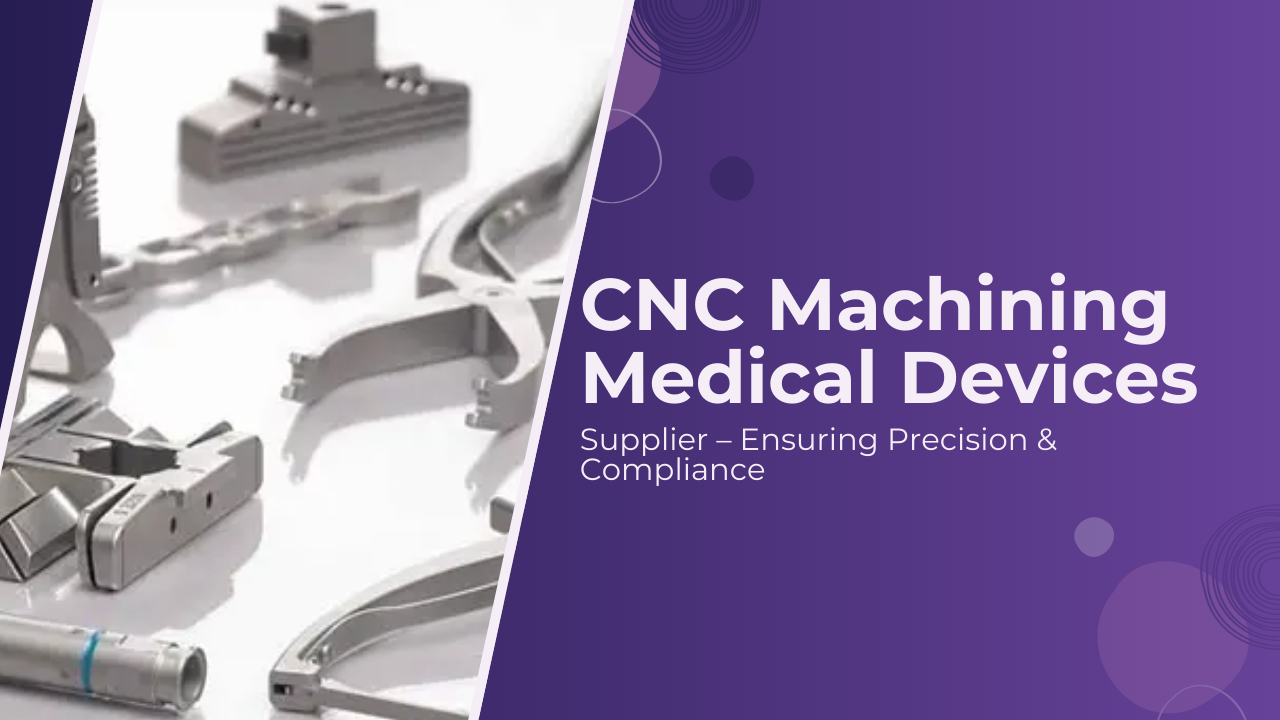Sourcing parts for CNC machining medical devices is not just about precision. It requires strict process control, validated workflows, and full traceability to meet ISO 13485 machining and FDA QSR requirements. Many suppliers focus only on dimensional accuracy in CNC machining medical devices but overlook critical elements like process validation (IQ, OQ, PQ), material certification, and documented risk management. This creates compliance gaps during audits, even when parts meet technical drawings.
To pass regulatory reviews, machined medical parts need controlled manufacturing processes, real-time documentation, and complete traceability from raw material to final delivery. Every process adjustment, inspection record, and material lot in CNC machining medical devices must be documented and directly linked to the finished part. This blog explains the technical requirements behind precision medical parts and highlights what medical device companies must demand from machining suppliers.
Why Precision Machining is Critical to Medical Device Manufacturing
Medical devices operate in environments where safety, biocompatibility, and performance are non-negotiable. Precision in CNC machining medical devices is not just about holding tolerances — it ensures functional integrity, material stability, and regulatory compliance. When components interact with human tissue, fluids, and surgical instruments, every micron matters. This section breaks down the specific technical demands driving precision in medical machining.
Precision Beyond Tolerances
For industrial components, ±50 microns is often acceptable. Precision requirements are much tighter in CNC machining medical devices because dimensional accuracy affects fit, function, and patient safety.
Here are the examples –
- Orthopedic implants from CNC machining medical devices rely on precise surface matching for stable bone integration.
- Catheter tips control fluid flow through bore diameters below 200 microns.
- Minimally invasive surgical tools require micro-sized components to fit within tight assemblies.
- Orthopedic drills, bone saws, and surgical instruments need optimized friction profiles to avoid excessive wear during surgery.
Medical parts with interference fit, such as bone screws, often need tolerances as tight as +0/-5 microns. Deviations impact osseointegration or cause loosening. Achieving this requires thermal compensation, closed-loop feedback, and advanced process control.
Complex Geometries
Modern medical devices demand more than simple shapes. Devices increasingly feature organic contours, ergonomic designs, and miniaturized components — often combining freeform surfaces with internal channels or threaded micro-features. Producing these parts requires –
- 5-axis simultaneous machining for organic curves and compound angles.
- High-speed spindles exceeding 20,000 RPM for machining stainless steel, titanium, and PEEK micro-features.
- Sub-spindle integration in CNC machining medical devices allows multi-side machining in a single setup, preserving alignment across all surfaces.
- High-pressure through-spindle coolant (up to 1000 PSI) for deep-hole drilling and micro-milling in tough biocompatible materials like cobalt chrome and titanium.
Many standard CNC shops rely on encoder-based positioning systems with micron-level accuracy at best. Medical machining, especially for implants and surgical tools, requires linear glass scales with positional resolution down to 0.1 microns. These scales provide real-time positional correction, compensating for thermal drift, machine vibration, and tool deflection.
Regulatory Expectations — Linking Precision to ISO 13485 Compliance
In ISO 13485 machining, precision is not just a manufacturing goal but a documented process requirement. Regulators, including the FDA, want to see how precision is achieved, verified, and controlled at every step. For medical parts, this requires:

- Process Validation (IQ, OQ, PQ), ensuring equipment, programs, and setups consistently deliver qualified parts.
- Documented Process Change Control, tracking even minor changes in tools, programs, fixtures, or materials.
- In-line dimensional inspection, capturing data from statistical process control (SPC) to show tolerance compliance across the entire batch — not just at final inspection.
- Material Traceability in CNC machining medical devices, linking every machined part back to its raw material certification, purchase order, and lot number.
Why Do Medical CNC Orders Often Go Off Track — And What Can You Do About It?
Despite clear drawings and quality expectations, many CNC machined medical parts face production errors, regulatory non-conformance, or product recalls. The root cause is rarely a single mistake — it’s often process gaps, incorrect materials handling, or incomplete validation. This section highlights the most common failure points and explains how Frigate applies advanced process controls, documentation discipline, and medical-grade machining expertise to prevent them.
Process Drift
Maintaining dimensional accuracy in CNC machining is challenging enough, but in medical manufacturing, precision must hold steady across the entire production run. Process drift in CNC machining medical devices — caused by factors like tool wear, spindle thermal expansion, fixture misalignment, and operator setup variability — gradually pushes dimensions out of tolerance. In medical device manufacturing, such deviations compromise part performance, regulatory compliance, and patient safety.
Frigate mitigates process drift through real-time process monitoring and automated compensation. Advanced tool life management systems continuously track tool wear, automatically applying offset updates after each cycle. Critical dimensions are verified in real time using in-process probing (IPM) immediately after machining, ensuring each cut remains within specification. Frigate employs Statistical Process Control (SPC) on all critical-to-quality (CTQ) features to complete the control loop, with full traceability for each lot. This comprehensive approach guarantees process stability — even during long production runs — delivering both dimensional confidence and regulatory readiness.
Medical Regulations
While many CNC suppliers excel at maintaining tight tolerances, they often lack familiarity with the specialized regulatory and quality requirements of medical manufacturing. Compliance with ISO 14971 Risk Management, FDA’s Quality System Regulation (QSR), and medical-specific material controls demand far more than precision machining alone. Proper documentation practices for CNC machining medical devices, risk mitigation strategies, and process transparency are essential.
Frigate addresses this gap with a risk-first approach to medical machining. Each project begins with a Process Failure Modes and Effects Analysis (FMEA) to identify potential failure points at each machining step. Work Instructions (WI) are directly linked to validated process parameters defined during Operational Qualification (OQ). Every shipment is accompanied by a comprehensive Device History Record (DHR), including:
- Material certifications and traceability.
- Process change notices (PCNs).
- In-process inspection data.
- Final dimensional reports.
This robust documentation package ensures straightforward regulatory audits, with full process traceability from raw material to finished part.

Biocompatibility Risks
In standard CNC machining environments, general-purpose cutting fluids and mixed-metal setups are common. However from CNC machining medical devices, these practices introduce unacceptable biocompatibility risks, including cross-contamination, residual processing fluids, and bioburden accumulation — all of which can lead to failed cytotoxicity testing and regulatory non-compliance.
Frigate eliminates these risks through a segregated manufacturing approach. Each material type — titanium, stainless steel, or medical polymers — is machined in a dedicated medical cell, avoiding cross-contamination. Cutting fluids are carefully selected to meet USP Class VI biocompatibility standards. Post-machining, parts undergo ultrasonic cleaning in deionized water, followed by particle count analysis to verify cleanliness at a microscopic level. This rigorous process ensures that every part is clinically clean and biocompatibility-ready.
Incomplete Process Validation
While SPC is common in automotive and aerospace machining, medical manufacturing requires a higher level of process control: formal process validation. This means proving upfront — before production begins — that each machining process can consistently produce conforming parts under real-world conditions. Many suppliers fail to apply Installation Qualification (IQ), Operational Qualification (OQ), and Performance Qualification (PQ) frameworks to CNC machining medical devices, leaving dangerous gaps in regulatory compliance.
Frigate integrates a complete IQ/OQ/PQ validation protocol into every medical project. Each machine’s calibration, positioning accuracy, and environmental stability are verified during IQ. In OQ, proven process windows — including speeds, feeds, tool paths, and cutting parameters — are established using Design of Experiments (DOE). Finally, PQ confirms that real production lots consistently meet tolerance, surface finish, and cleanliness requirements, with actual CpK analysis to quantify process capability. This rigorous approach ensures Frigate’s processes are capable and regulatory audit-ready.
Inadequate Documentation
Regulatory bodies such as the FDA and notified bodies under ISO 13485 expect complete traceability for every medical component. This means linking each finished CNC machining medical devices to its original design files, raw material certifications, process history, in-process inspections, and change records. Unfortunately, many CNC suppliers only provide final inspection reports, leaving critical traceability gaps that can trigger audit findings or regulatory warnings.
Frigate ensures complete documentation through a fully digital Quality Management System (QMS), automatically generating a comprehensive Device History Record (DHR) for every lot. This DHR includes:
- Original design and engineering records.
- Full material traceability and certifications.
- All engineering change notices (ECNs).
- In-process and final inspection reports.
- Cleaning and packaging validation records.
This level of documentation not only ensures seamless regulatory compliance and simplifies audits, customer quality reviews, and post-market surveillance.
Surface Finish
In medical machining, surface finish is functional, not just aesthetic. For implants, surface roughness directly impacts osseointegration (tissue bonding). It affects bacterial adhesion for surgical instruments from CNC machining medical devices, which plays a key role in sterility. In assemblies such as press-fit implants, surface finish governs fit, wear rates, and mechanical integrity. Medical standards often call for surface roughness below 0.4 µm Ra to minimize infection risks and enhance performance.
Frigate ensures precise surface control using white light interferometry, capable of measuring surface roughness to a resolution of 0.05 µm Ra. Internal passages and complex features are deburred using abrasive flow machining (AFM), ensuring uniform surface quality even in hard-to-reach areas. For stainless steel implants, electropolishing is applied to achieve ultra-smooth, corrosion-resistant surfaces with roughness below 0.4 µm Ra. This metrology-driven approach ensures that every medical component meets mechanical fit and clinical safety requirements, helping lower the risk of post-surgical infection or implant rejection.

Conclusion
Precision isn’t just a challenge in CNC machining medical devices — it’s a regulatory and quality challenge. Every micron matter and every undocumented process change is a risk to regulatory approval and patient safety.
Frigate gives you more than parts — we give you documented precision, validated processes, and a regulatory-ready manufacturing partner.
Contact Frigate for CNC machining medical devices that meet precision, process control, and industry standards.




